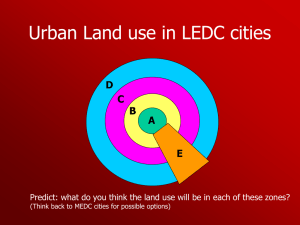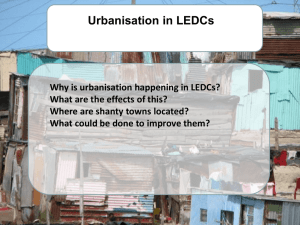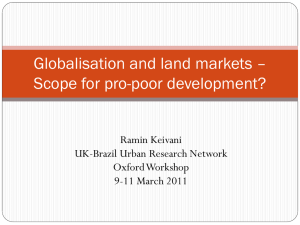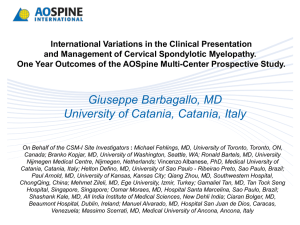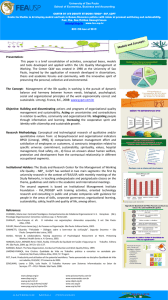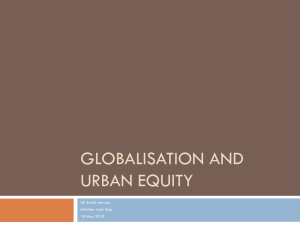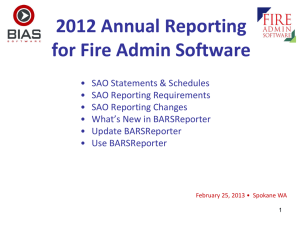The Sao Paulo Perspective
advertisement
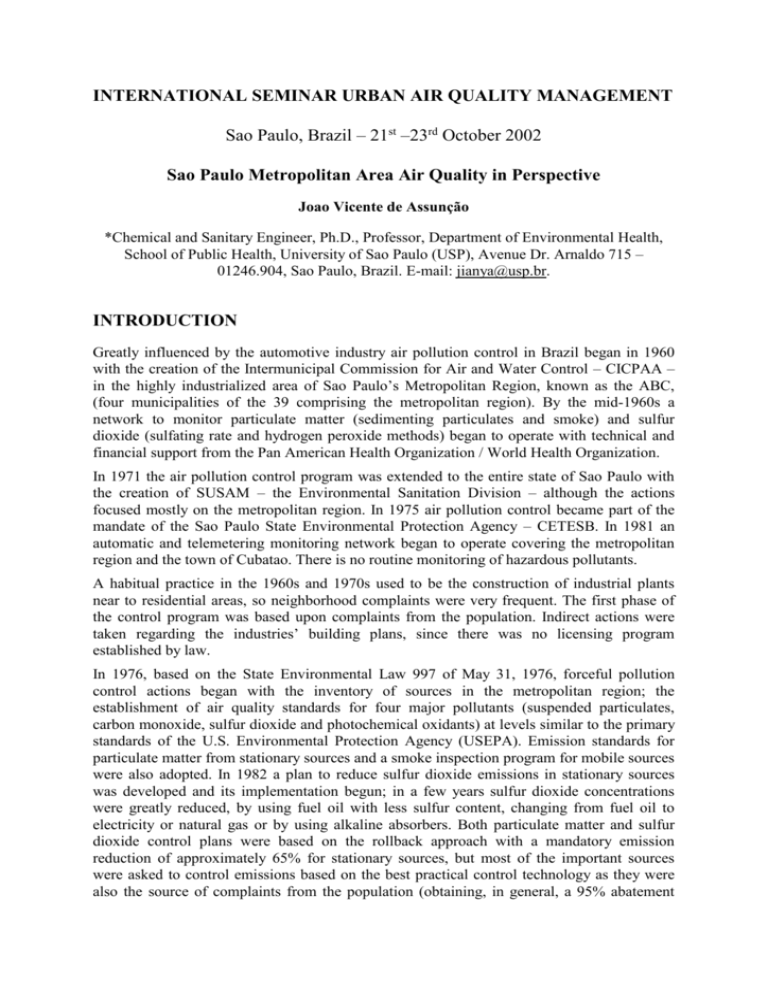
INTERNATIONAL SEMINAR URBAN AIR QUALITY MANAGEMENT Sao Paulo, Brazil – 21st –23rd October 2002 Sao Paulo Metropolitan Area Air Quality in Perspective Joao Vicente de Assunção *Chemical and Sanitary Engineer, Ph.D., Professor, Department of Environmental Health, School of Public Health, University of Sao Paulo (USP), Avenue Dr. Arnaldo 715 – 01246.904, Sao Paulo, Brazil. E-mail: jianya@usp.br. INTRODUCTION Greatly influenced by the automotive industry air pollution control in Brazil began in 1960 with the creation of the Intermunicipal Commission for Air and Water Control – CICPAA – in the highly industrialized area of Sao Paulo’s Metropolitan Region, known as the ABC, (four municipalities of the 39 comprising the metropolitan region). By the mid-1960s a network to monitor particulate matter (sedimenting particulates and smoke) and sulfur dioxide (sulfating rate and hydrogen peroxide methods) began to operate with technical and financial support from the Pan American Health Organization / World Health Organization. In 1971 the air pollution control program was extended to the entire state of Sao Paulo with the creation of SUSAM – the Environmental Sanitation Division – although the actions focused mostly on the metropolitan region. In 1975 air pollution control became part of the mandate of the Sao Paulo State Environmental Protection Agency – CETESB. In 1981 an automatic and telemetering monitoring network began to operate covering the metropolitan region and the town of Cubatao. There is no routine monitoring of hazardous pollutants. A habitual practice in the 1960s and 1970s used to be the construction of industrial plants near to residential areas, so neighborhood complaints were very frequent. The first phase of the control program was based upon complaints from the population. Indirect actions were taken regarding the industries’ building plans, since there was no licensing program established by law. In 1976, based on the State Environmental Law 997 of May 31, 1976, forceful pollution control actions began with the inventory of sources in the metropolitan region; the establishment of air quality standards for four major pollutants (suspended particulates, carbon monoxide, sulfur dioxide and photochemical oxidants) at levels similar to the primary standards of the U.S. Environmental Protection Agency (USEPA). Emission standards for particulate matter from stationary sources and a smoke inspection program for mobile sources were also adopted. In 1982 a plan to reduce sulfur dioxide emissions in stationary sources was developed and its implementation begun; in a few years sulfur dioxide concentrations were greatly reduced, by using fuel oil with less sulfur content, changing from fuel oil to electricity or natural gas or by using alkaline absorbers. Both particulate matter and sulfur dioxide control plans were based on the rollback approach with a mandatory emission reduction of approximately 65% for stationary sources, but most of the important sources were asked to control emissions based on the best practical control technology as they were also the source of complaints from the population (obtaining, in general, a 95% abatement efficiency or more for particulate matter and 80% for sulfur dioxide). Law 997 also specified a licensing system to control the deployment of new stationary sources. In 1986 a program of emission reductions for new vehicles was adopted through the enactment of the Federal Automobile Pollution Control Law - PROCONVE – which set emission standards for carbon monoxide, hydrocarbons and nitrogen oxides in regard to Otto vehicles, and smoke for Diesel-powered vehicles. In 1986 a Federal Resolution was passed (CONAMA – the National Environmental Council - Resolution 01/86) stating the need to submit environmental impact studies for major environmental pollution sources prior to the approval of construction plans and licensing of the source. In 1990 air quality standards were revised. The new standards included the concept of primary standards for the protection of public health and secondary standards for the protection of the environment and human well-being in regard to suspended particulates, inhalable particulates (PM10), smoke, carbon monoxide, sulfur dioxide, nitrogen dioxide and ozone (Table 1). Command and control is the main approach being used for the administration of air quality. The use of the pollution prevention approach is new and it is focused on by state law 9472 enacted in December 1996 (Traldi Meneses 2001). There is no routine verification of the efficacy of CETESB new sources licensing system in the air quality. Moreover, the licensing system is a strong tool for preventing the installation of new sources without pollution control systems as well as for preventing the installation of high polluting industries in the region (Tartalia e Silva 2002)3. At present restriction to emissions of nitrogen oxides (NOx) and volatile organic compounds (VOCs) is applied only to mobile sources, and only to new vehicles, according to the federal resolution of 1986 (CONAMA resolution 1/1986). VOC Pollution control system is mandatory only to sources that cause or may cause nuisance problems. With the new federal governmental program of incentive to the implantation of powerplants the control of NOx and VOC in stationary sources is being considered, because of its ozone formation potential. Although the vehicle fleet has increased more than 750% in the city of Sao Paulo since 1970 air quality in the region did not worsen in the same proportion. In fact, for some pollutants, it improved. At present major air pollution problems are related to fine particulates (PM10), carbon monoxide and ozone. It must be noted that in regard to the situation in the 1970s air pollution now covers a much broader area both in the city of Sao Paulo and in the metropolitan region. Industrialization and land occupation process, together with meteorological conditions unfavorable to the dispersion of pollutants (frequent low altitude thermal inversions in wintertime, and strong solar radiation during other seasons) and a topography formed by floodplain surrounded by mountains in the north and northwest, receiving predominant winds from the ocean at southeast (approximately 60 kilometers away) result in conditions that favor deterioration of air quality (Ribeiro and Assuncao, 2000)1. A few studies have been conducted (Ulke & Andrade, 2000; Andrade et al., 2000; Massambani & Andrade, 1994; Guardani et al., 1999), and some studies concerning ozone formation in the region are being planned; the number of studies on ozone formation process and the participation of their precursors are likely to increase in view of both, the present status of ozone levels in the region, and because of the fact that ozone is becoming a problem in several other areas in the state of Sao Paulo. 2 Table 1. Brazilian national air quality standards (g/m3) Pollutant Total Suspended Particulates Inhalable Particulates (PM10) Smoke Primary Standard 240 (24-hour average ) 80 (annual geometric mean) 150 (24-hour average ) 50 (annual arithmetic mean) 150 (24-hour average ) 60 (annual arithmetic mean) Sulfur Dioxide 365 (24-hour average ) 80 (annual geometric mean) Carbon Monoxide 40,000 (1-hour average) 10,000 (8 hour average ) Nitrogen Dioxide 320 (1-hour average) 100 (annual arithmetic mean) Ozone 160 (1 hour average) Source: Brazil, CONAMA Resolution # 3, 19908. Secondary Standard 150 (24-hour average ) 60 (annual geometric mean) Same as primary 100 (24-hour average ) 40 (annual arithmetic mean) 100 (24-hour average ) 40 (annual geometric mean) Same as primary 190 (1-hour average) 100 (annual arithmetic mean) Same as primary AIR EMISSIONS TRENDS The air quality of the Metropolitan Region of Sao Paulo is affected mostly by mobile sources. During the 1960s and 1970s air quality was strongly influenced by industrial sources, as shown in Table 2. Nowadays emissions come mainly from vehicles, as shown by Table 3. Light-duty vehicles are powered by gasohol, a gasoline/ethanol blend (mixture of 78% gasoline and 22% ethanol) and by plain ethanol. About 40% of the total fuel volume is ethanol (Colón et al., 2001). Heavy-duty vehicles are fueled by diesel oil. Table 2: Inventory of emissions in the metropolitan region of Sao Paulo, 1977 (1 000 metric tons) Source CO HC NOx SOx PM* Gasohol-fueled vehicles 1,557.0 183.8 51.7 11.2 8.5 Diesel-fueled vehicles 58.3 9.8 40.4 20.9 3.5 Other sources 42.9 23.9 2.6 0.32 30.8 Industrial sources 56.6 39.3 29.1 288.6 111.2 Total 1,715.0 257.0 124.0 321.0 154.0 % from mobile sources 94.2 75.3 74.3 10.0 7.8 *Particulate matter Source: CETESB apud Assuncao & Galvao Filho, 1999 3 Table 3: Inventory of emissions in the metropolitan region of Sao Paulo, 2001 (1,000 metric tons) Source CO HC NOx SOx PM* Gasohol-fueled vehicles 780.8 214.1 44.4 10.2 5.1 Ethanol-fueled vehicles 207.5 40.4 12.7 Diesel-fueled vehicles 433.3 70.6 316.5 10.9 19.7 Taxis 3.5 0.7 0.7 0.4 0.2 Motorcycles 217.5 44.2 1.1 0.8 0.6 Other types of transportation and 13.0 8.1 related sources Industrial sources ** 38.6 12.0 14.0 17.1 31.6 Total 1,681.2 395.0 389.4 39.4 65.3 % from mobile sources 97.7 97.0 96.4 56.6 51.6 * Particulate matter; **Emissions from most important sources, representing approximately 90% of total emissions; 1990 data for CO, HC and NOx and 1998 data for SOx and particulates. Source: CETESB, 2002 Table 4 presents a comparison between emissions at the beginning of the air pollution control program developed by CETESB – the Sao Paulo State Environmental Protection Agency – in the mid-1970´s and in 2001. Sulfur oxide emissions decreased 88% and particulate matter emissions decreased 58.4%. Carbon monoxide emissions, however, decreased only 3.1% and hydrocarbon emissions increased 46.6%. The worst case is nitrogen oxide emissions, which increased 208.1%. Mobile sources substantially increased their contribution to the air emissions in the region in terms of HC, NOx, SOx and particulate matter. Most carbon monoxide emissions come from mobile sources. Table 4. Comparison of emissions in 1977 and 2001 Parameter CO Total emissions in 1977 1,715 Total emissions in 2000 1,681.2 Alteration in the period (%) -2.0 Contribution of mobile sources (%) in 1977 94.2 Contribution of mobile sources (%) in 2001 97.7 * Particulate matter HC NOx 257 124 395.0 389.4 +53.7 +214.0 75.3 74.3 97.0 96.4 SOx 321 39.4 -87.7 10.0 56.6 PM* 154 65.3 -57.6 7.8 51.6 AIR QUALITY TRENDS Although the vehicle fleet has increased more than 750% in the city of Sao Paulo since 1970 air quality in the region did not worsen in the same proportion. In fact, for some pollutants, it improved. At present major air pollution problems are related to fine particulates (PM10), carbon monoxide and ozone. It must be noted that in regard to the situation in the 1970s air pollution now covers a much broader area both in the city of Sao Paulo and in the metropolitan region. Particulates Total suspended particulate levels, measured by high volume samplers, still exceed air quality standards, and in some periods of poor dispersion conditions reach attention levels. In regard 4 to smoke, measured by the WHO reflectance method, there is a clear tendency for air quality conditions to improve, shown in Figure 1. Although air quality standards are exceeded on some days attention levels are not attained. The levels of inhalable particulates still exceed air quality standards, but in 2000 the attention levels were not exceeded. Studies applying receptor model technique for source apportionment were performed in the region to subsidy control actions. Alonso et al. (1997) concluded that chemical mass balance (CMB) receptor modeling indicated that carbonaceous material plays an important role in the aerosol composition; that the three major source categories contributing to the fine particles are vehicles, secondary carbon, and sulfates; and that the main contributors to coarse particles and total suspended particulate are road dust and vehicles. All sampling sites presented the same general pattern in terms of source contribution, although this contribution varied from site to site. In a study conducted by CETESB in 1986-1987 it was found that levels of carbonaceous material in the particulate matter of Sao Paulo city are very high compared with some other US cities; total carbon was responsible for 40% of the total mass of suspended particulate and the contribution of organic carbon was 32% in the average. (Cetesb, 1995) Sulfur Dioxide In regard to sulfur dioxide, the present situation is promising due to a successful control program implemented during the first half of the 1980s and to the fact that primary air quality standards were not exceeded since 1986, except a few times. Even the more stringent air quality standard proposed by the World Health Organization (120 μg/m3 – 24-hour average) has been met in the last four years. Figure 1 shows the trend of average sulfur dioxide levels in the region since 1975. Carbon Monoxide Air quality levels of CO are influenced basically by gasohol and ethanol-fueled vehicle emissions The vehicle fleet – 520,000 vehicles in the city in and 659,000 vehicles in the Metropolitan Region in 1970 - grew approximately ten-fold from 1970 to 2001 and currently comprises approximately 5 million cars in the city and 6 million cars in the Metropolitan Region, but emissions decreased about 2%. This decrease was due to the carbon monoxide emission limits imposed on new vehicles since 1989, to the use of plain ethanol and a mixture of 22% of ethanol in gasoline and to the restriction to vehicles use, in the city of Sao Paulo. An inspection and maintenance program is already part of federal legislation and should be enforced soon. 5 Non-compliance with air quality standards and the occurrence of attention levels were frequent by the end of the 1970s; the average maximum concentration was 21 ppm for an 8hour mean in the period between 1976 and 1980 and 16.4 ppm in the period of 1996-2000. Maximum 8-hour concentration in the period 1976-1980 was 29.8 ppm and 18.1 ppm in the period of 1997-2001 being the maximun in 2001 of 13.5 ppm. In the last two years noncompliance with air quality standards has been scarce and no attention levels were decreed between 1998 and 2001 as shown in Table 5. Source of data: Cetesb Figure 1. Annual mean concentration trend in the Metropolitan Region of Sao Paulo 1975-2000, for smoke and sulfur dioxide . 160 140 Smoke mean Smoke STD SO2 mean SO2 STD 100 80 60 40 20 0 19 75 19 76 19 77 19 78 19 79 19 80 19 81 19 82 19 83 19 84 19 85 19 86 19 87 19 88 19 89 19 90 19 91 19 92 19 93 19 94 19 95 19 96 19 97 19 98 19 99 20 00 Concentration (ug/m3) 120 Year Table 5. Number of times CO standard was exceeded and attention level declared in SPMR in ten monitoring stations (Pinheiros Station was excluded) Year Parameter 1997 1998 1999 2000 2001 Number of std exceedances 65 36 18 12 13 Number Attention levels declared 7 0 0 0 0 6 Figura 2. Number of exceedances of 8-hours CO air quality standard and attention level in the period of 1983-2000 in the Cerqueira César monitoring station 120 100 number of exceedances > STD > ATT Level 80 60 40 20 0 1983 1984 1985 1986 1987 1988 1989 1990 1991 1992 1993 1994 1995 1996 1997 1998 1999 2000 year Figure 2 shows number of violations of air quality standards and of attention levels in the Cerqueira Cesar Station, located in the downtown region of the city of Sao Paulo. (Source of data: Cetesb) Ozone As we are aware, ozone is the main constituent of photochemical smog in urban areas. Its main precursors are nitrogen oxides and hydrocarbons (including other volatile organic compounds). In this case the situation in the city of Sao Paulo is of great concern, since the emissions of both classes of pollutants increased between 1976 and 2000, shown in Table 4. This increase will lead to high ozone level in a spreader area, although maximum concentrations declined in relation to the 1980s, violation of the air quality standard and attainment of attention level are frequent. As described by the Environmental Agency of the state of Sao Paulo (CETESB) in the air quality report for 2000, “in the case of ozone the air quality standard (160 g/m3 for 1 hour period) and the attention level (200 g/m3, for 1 hour period) are frequently exceeded” (CETESB, 2001). Figures 3 shows the number of exceedances of the 1-hour primary air quality standard (160 ug/m3) and in Figure 4 is shown the number of times the Sao Paulo state attention level (200ug/m3 for 1 hour period) were declared. 7 60 50 40 30 20 10 0 1997 1998 D. Pedro II Mooca 1999 Ibirapuera 2000 Sao C do Sul Osasco S. M. Paulista 2001 Maua Figure 3. Number of times the 1 hour-Primary Ozone Standard was exceeded in SPMR, by station, in the period of 1997 – 2001 (Source of data Cetesb 2002) 25 20 15 10 5 0 1997 D. Pedro II 1998 Mooca 1999 Ibirapuera 2000 Sao C do Sul Osasco 2001 S. M. Paulista Maua Figure 4. Number of times the Attention Level was declared in SPMR, by station, in the period of 1997 – 2001 (Source of data Cetesb 2002) VOC and Toxic Air Pollutants A recent survey of volatile organic compounds associated with automotive emission in the urban air shed of Sao Paulo city, made by Colón et al. (2001) showed that overall results demonstrate that mean concentrations of single-ring aromatics are 2-3 times higher, volatile 8 aldehydes 10-100 times higher, and single alcohols 10-100 times higher as compared to results of another recent study done by US EPA in the Los Angeles basin. C4-C11 n-alkanes were only slightly elevated in Sao Paulo. Levels of benzene in Sao Paulo city reported by Gee and Sollars (1998) are much higher than in several cities in the United States of America and higher than levels observed in several other cities in the world (Quito in Ecuador, Caracas in Venezuela, Santiago in Chile, Manilla in the Philipines); only Bangkok in Thailand had levels higher than Sao Paulo, but Colón et al. (2001) observed levels of benzene that in Sao Paulo are less than half of the one reported by Gee and Sollars. Oliveira (1996) reported levels of dioxins and furans in Sao Paulo city in the range of 86 – 187 fg I-TEQ/m3. Assuncao et al. (2001) in a study performed from November 2000 to August 2001 reported levels in the range of 39 to 751 fg I-TEQ/m3 with measurements done by collecting samples according to EPA Method T09A, using PUF (polyurethane foam) samplers in 24-hours sampling time simultaneously in three different sites. The analyses for the presence of dioxins and furans in these samples were performed by using HRGC/HRMS, according to EPA Method 8290. The samples were collected in three different areas of the city of Sao Paulo. The first area - SS1 - is located close to downtown (Cerqueira Cesar district) and influenced by an intense traffic of cars and buses. The second area - SS2 - is a typical middle-class residential area (Vila Mariana district), subject to the influence of a health service waste incinerator (about 90 metric tons a day without air pollution control systems) and light traffic. The third area - SS3 - is an area with heavy traffic and a mix of industrial, commercial and service activities (Lapa district). Sampling sites SS1 and SS2 showed concentrations of dioxins and furans in the range of 40 to 223 fg I-TEQ/m3 while in the sampling site SS3 the range was 39 to 751 fg I-TEQ/m3. Lead was of concern until the early 1980s. The situation changed due to the use of ethanol in gasoline in Brazil since early 1980s in place of tetraethyl lead and also because of the use of plain ethanol. Concentration of lead in the air in the metropolitan region was reduced from the maximum quartely average concentration of about 1.6 μg/m3 in 1978 to a maximum of about 0.4 μg/m3 in 1983 (CETESB, 1987). THE FUTURE This historical overview of air pollution in the metropolitan region of Sao Paulo indicates that control measures - like legislation and enforcement - technology, cooperation, negotiation and education achieved very positive results in terms of pollution control and are important tools to minimize health risks and to promote a good quality of life. However, results in terms of public health might be neutralized by the increase in the number of vehicles and of uncontrolled urban and economic activities. A lot remains to be done in terms of transforming Sao Paulo into a healthy one. The Sao Paulo Metropolitan Region will reach 20.4 million inhabitants by 2015, a 15% population increase in relation to the situation in year 2000 (17.8 million inhabitants), but the Sao Paulo City itself is slowing down in terms of population growth and it will maintain close to 11 million inhabitants. Number of cars are still increasing in the region with an addition of 200,000 cars per year in the metropolitan area. The number of cars will reach about 9,000,000 by 2015, that is, approximately 2.3 inhabitants per car, about the same ratio of Sao Paulo city nowadays. 9 The region will continues to change from industrial sector to service sector and transportation sources will increase participation in the overall air pollution levels. Levels of carbon monoxide will continue to go down, as car inspection and maintenance program is expected to be established soon, and old cars are being replaced by new ones with more stringent emission levels. NOx and VOC control actions are slower than for other pollutants then we can expect maintenance or increased levels of ozone in the area. Photochemical pollution is a complex issue and a lot studies must be carried out before we can fully understand it, specially in an area with a very unique combination of fuels in the world (diesel, gasohol, ethanol, and some natural gas), as the Sao Paulo Metropolitan Region. Inhalable particulate is another problem that must be faced since Also highly toxic pollutants need a special inventory and monitoring program followed by a well-planned control program, and benefits, specially on health should be addressed. As better public transportation is being a concern of most of the SPMR municipalities and also of the state government, and it can lead to an increase in public transportation use by people and consequently less use of private cars. Also the circulation in the City of Sao Paulo of trucks and buses, and some light duty cars, coming from other states, will be rearranged in the near future with the construction of a circular road around Sao Paulo City. These measures will influence positively the air quality in the city. Bibliography Alonso, C.D; Martins, M.H.R.B; Romano, J; Godinho, R. Sao Paulo aerosol characterization study. Journal of the Air and Waste Management Association, v. 49 p. 642-645, 1997. Andrade, M.F., Miguel, A.H., Ulke, A.G. Ozone modelling in an ethanol-, gasoline-, and diesel-fuel environment: the Metropolitan Area of São Paulo, Brazil. Proceedings of the 6th Conference on southern Hemisphere Meteorology and Oceanography, pp. 17-18., 2000. Assunção JV; Pesquero RC; Carvalho LRF; Nóbrega RP. Dioxinas e Furanos: vias de exposição da população [Dioxins and Furans: population exposure ways]. São Paulo: Faculdade de Saúde Pública da USP, 2001. (Relatório Científico de Projeto de Pesquisa – Processo Fapesp 98/11655.6) Assuncao, JV de; Galvao Filho, JB. Discussing the Air Pollution of Sao Paulo City - Brazil. Proceedings of the 92nd Annual Meeting and Exhibition of the Air and Waste Management Association (AWMA); 1999 June 18-24; Saint Louis (USA). Pittsburgh: AWMA; 1999. Assuncao, JV de; Ribeiro, H Overview of the Last 30 Years of Air Pollution Control Programs and Health Effects Studies in the Metropolitan Region of Sao Paulo – Brazil. 95th Conference of the Air and Waste Management Association (AWMA), Baltimore, EUA, June 23-27 2002. Brasil. Resolucao CONAMA 01/86. Diario Oficial da Republica Federativa do Brasil, Brasilia, 1986. Brasil. Resolucao CONAMA 03 de 28 de junho de 1990. Diario Oficial da Republica Federativa do Brasil, Brasilia, 16 ago 1990 p 15518. Colón, M; Pleil, J.D.; Hartlage, T.A; Guardani, M.L; Martins, M.H. Survey of volatile compounds associated with automotive emissions in the urban airshed of Sao Paulo, Brazil. Atmospheric Environment 35 (2001) 4017-4031. 10 Companhia de Tecnologia de Saneamento Ambiental (CETESB). Relatório de qualidade do ar no Estado de Sao Paulo 2001 (Air quality report for the State of Sao Paulo, 2001). Sao Paulo: CETESB, 2002. Companhia de Tecnologia de Saneamento Ambiental (CETESB). Relatório de qualidade do ar no Estado de Sao Paulo 1994 (Air quality report for the State of Sao Paulo, 1994). Sao Paulo: CETESB, 1995. Companhia de Tecnologia de Saneamento Ambiental (CETESB). Relatório de qualidade do ar no Estado de Sao Paulo 1986 (Air quality report for the State of Sao Paulo, 1986). Sao Paulo: CETESB, 1987. Gee, I.L; Sollars, C.J. Ambient air levels of volatile organic compounds in Latin America and Asian cities. Chemosphere 36 (11), 2497-2506, 1998. Guardani, M.L.G.; Nascimento, C.A.O.; Guardani, M.L.G.; Martins, M.H.R.B.; Romano, J. Study of atmospheric ozone formation by means of a neural network – based model. Journal of the Air and Waste Management Association, v. 49 p. 316-323, 1999. Massambani, O.; Andrade, M.F.. Seasonal behavior of tropospheric ozone in he Sao Paulo (Brazil) metropolitan area. Atmospheric Environment 28 (19), 3165-3169, 1994. Oliveira, M.C.N. Avaliacao de compostos organicos provenientes da queima de palha de cana-de-acucar em Araraquara e comparacao com medicoes efetuadas em Sao Paulo e Cubatao. Resultados Parciais (Evaluation of organic compounds from sugar cane burning in Araraquara and comparison with measurements in Sao Paulo and Cubatao. Partial results). Sao Paulo, CETESB, November, 1996 Ribeiro, H; Assuncao, JV de. Historical overview of air pollution in Sao Paulo metropolitan area, Brazil: influence of mobile sources and related health effects. In:Sucharov, LJ; Brebbia, CA. Urban transport VII – Urban transport and the environment in the 21st century. Southampton: WIT Press, 2001 Tartalia e Silva, A.C.T. Licenciamento ambiental de atividades industriais na região metropolitana de Sao Paulo: Vinte e cinco anos de atuação do estado. Master Dissertation, Faculdade de Saúde Pública. Universidade de São Paulo. S. Paulo, 2002. Traldi Meneses, LV. Instrumentos de política ambiental aplicados ao setor de tratamento de superfície na região metropolitana de Sao Paulo. Master Dissertation, Faculdade de Saúde Pública. Universidade de São Paulo. S. Paulo, 2001. Ulke, A.G., Andrade, M.F.Modelling photochemical air pollution in Sao Paulo, Brazil. Proceedings of the Millenium NATO/CCMS International Technical Meeting on Air Pollution and its Application. American Meteorological Society, Boston, USA, pp. 188-189, 2000. 11
